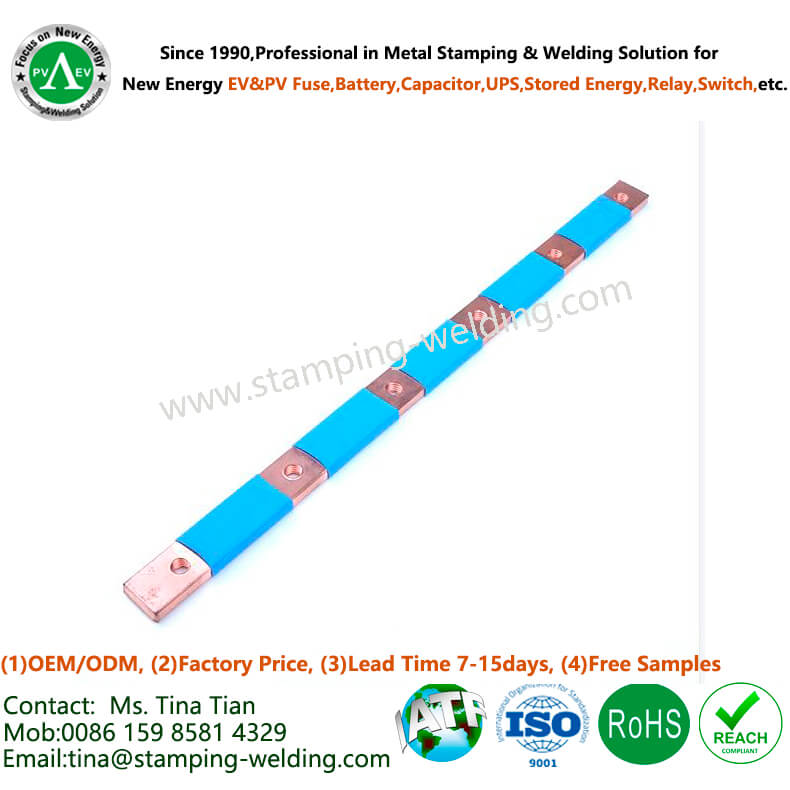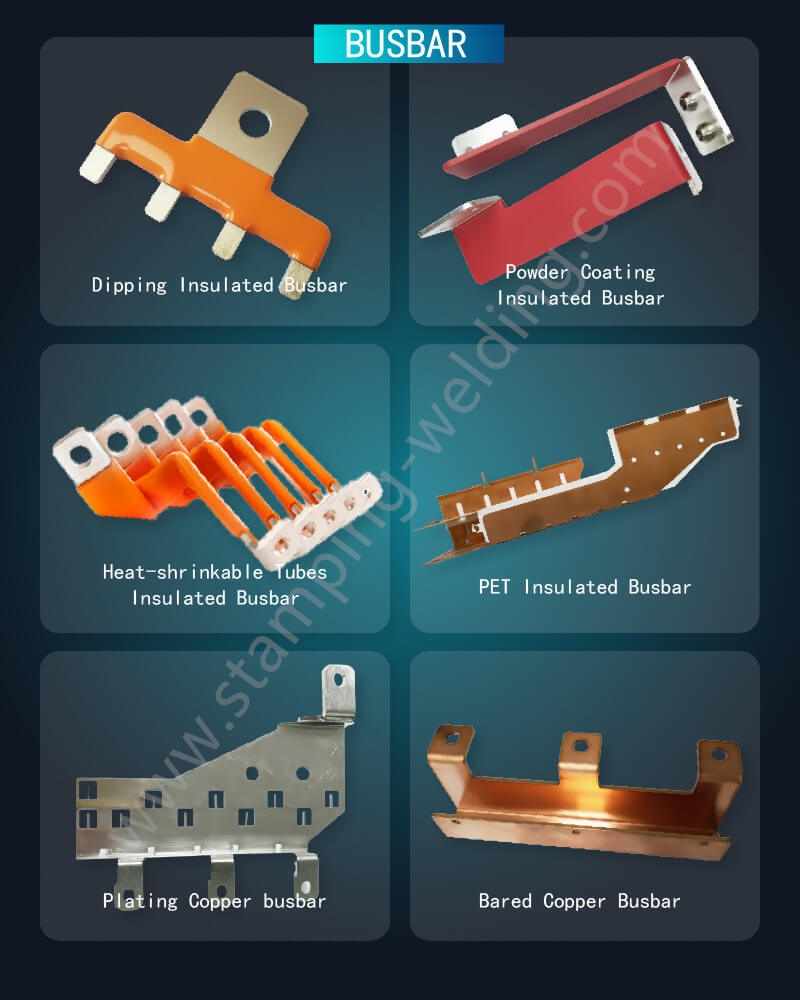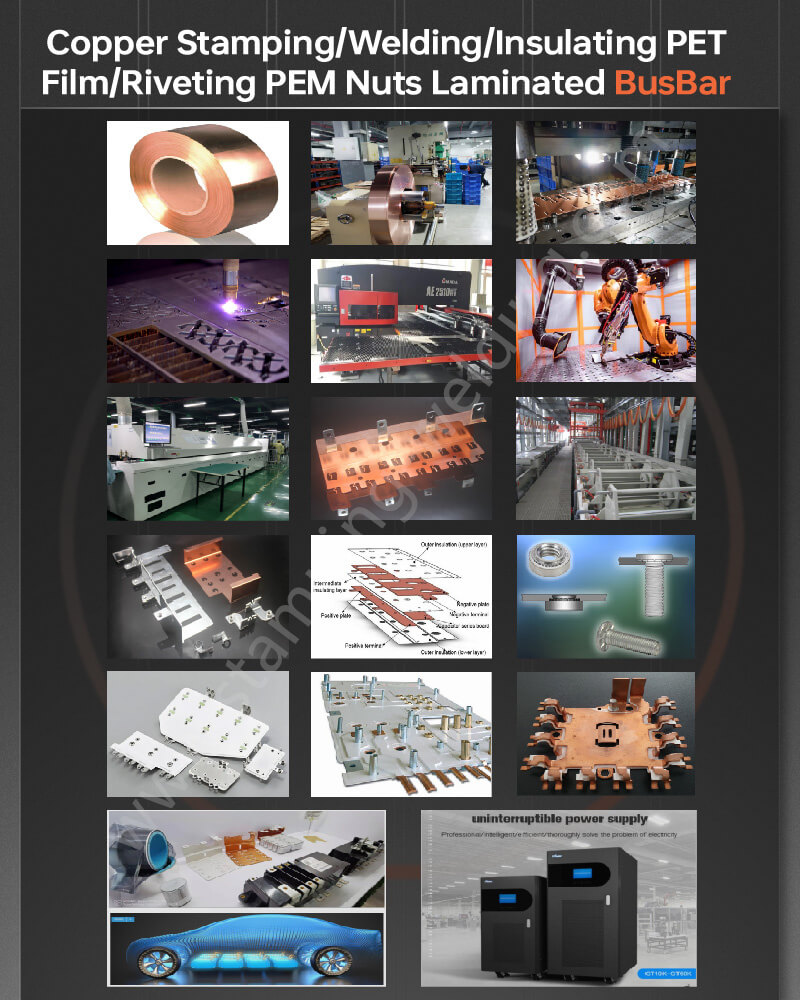

1- Products Name: Dipping Busbar for Connection
2- Base Material Standard:
GB : T2Y2 Copper
DIN: E-Cu58 (Number: 2.0065)
EN: Cu-ETP ( Number: CW004A)
ISO: Cu-ETP
UNS: C11000
JIS: C1100
BS: C101
Purity ≥99.99% Copper, Conductivity %IACS≥97, Hardness 80~110HV, Tensile Strength 245-345MPa, other material also can be customized.
3-Surface Treatments:
(3.1) Silver plating
(3.2) Tin plating
(3.3) Nickel plating
(3.4) Ultrasonic cleaning
Normally plated thickness is 3μm to 12μm, but all upon customers' request.
4- Insulation Options:
(4.1) PET insulation paper (brands USA GTS, GERMANY KREMPEL, etc with white or milky white colors)
(4.2) PVC dipping (orange and green are the most popular colors)
(4.3) Epoxy powder coating (orange, green and grey are the most popular colors)
(4.4) PE heat shrink tube (orange, green, black, red are yellow are the most popular colors)
Flame Retardant / Fire Resistance: UL94-V-0 or upon you request;
Operating Temperature: -45ºC to +150 ºC
5- Copper Busbar Resistance: ≤0.00001Ω
6- Copper Busbar load voltage 3500VDC to 5000VDC and current 100A to 2000A
7- Copper Busbar Assembly Fixtures: USA PEM stainless nuts, studs, standoffs, screws, etc
8- Free Samples:1-10pcs is allowed
9- Lead Time:Orders 7-10days,Samples 10-20days(including the tooling/die production of Copper Stamped Part);
10- Packing: pearl cotton/blister box inside and carton/pallet outside
11- Certifications: ISO9001, IATF16949, RoHS, REACH, etc.
12- Production Capacity: 50,000,000 pcs/month
13- Applications: film capacitors for new energy electric vehicles and hybrid vehicles, new energy vehicle battery packs, new energy photovoltaic energy storage, power appliances, distribution cabinets, rail transit, cloud server uninterruptible power supplies and other power systems.
Dipping busbars for connections in power systems typically involves a process where busbars are coated or dipped in a protective material to enhance their electrical performance, reliability, and safety. Here's an overview of the application and advantages:
1. Purpose:
The primary purpose of dipping busbars for connections in power systems is to improve their insulation and protection against environmental factors, ensuring reliable and safe electrical connections.
2. Insulation and Protection:
Dip Coating: Busbars are often coated with an insulating material through a dipping process. This coating serves as a protective layer, preventing accidental contact, reducing the risk of short circuits, and offering insulation against environmental elements such as moisture and corrosive agents.
3. Corrosion Resistance:
The dipped coating provides corrosion resistance, which is particularly important in power systems where exposure to different environmental conditions may lead to corrosion over time. Corrosion-resistant coatings help maintain the integrity of the busbars and ensure long-term reliability.
4. Electrical Insulation:
Preventing Electrical Contact: The insulation layer prevents unintended electrical contact between busbars or between busbars and other components. This is crucial for avoiding short circuits and maintaining the safety and efficiency of the power system.
5. Ease of Installation:
The dip-coating process can result in a smoother and more consistent surface on the busbars, making them easier to handle during installation. This contributes to the efficiency of the installation process.
6. Environmental Considerations:
Dipping busbars in protective coatings allows them to withstand various environmental conditions, including temperature variations, humidity, and chemical exposure. This is particularly important in power systems where reliability is paramount.
7. Customization for Applications:
Different insulating materials can be used for dip coating, allowing for customization based on the specific requirements of the power system. Factors such as temperature resistance, dielectric strength, and chemical compatibility can be considered in material selection.
8. Compliance with Standards:
Dipping busbars for connections is often done in compliance with electrical standards and regulations. Meeting these standards is essential for obtaining approvals and certifications for the power system.
9. Longevity and Reliability:
The protective coating enhances the longevity and reliability of busbars by preventing issues such as corrosion, electrical faults, and insulation breakdown. This is crucial for the overall performance of the power system.
It's important to note that the specific materials used for dip coating and the process details may vary based on the requirements of the power system and industry standards. When implementing such practices, it's recommended to adhere to relevant guidelines and consult with professionals to ensure the effectiveness and safety of the coated busbars in the specific power system application.


Contact Information:
Ms.Tina Tian (Sales Manager&Technology Engineer)
Xiamen Apollo Stamping Welding Technology Co., Ltd
Apollo Electronic Components (Xiamen) Co.,Ltd
Add: No.2, Chengyi North Road, Jimei Software Park, Jimei District, Xiamen City, Fujian Province, China, 361022
Mob/WhatsApp/WeChat: 0086-15985814329
Email: tina@stamping-welding.com
Web: www.stamping-welding.com , www.china-electronic-components.com
Since 2010, professional in Metal Stamping & Welding Solutions for New Energy EV & PV Fuse, Battery, Capactior, Relay, Switch, ect!